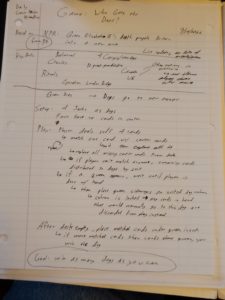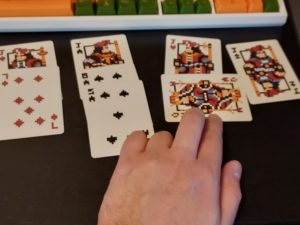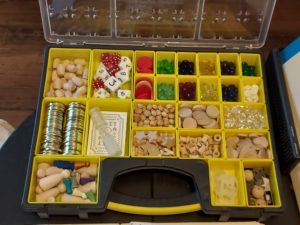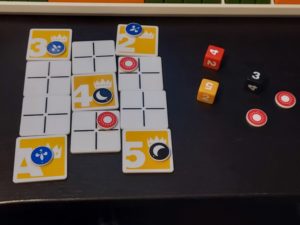As a very, very part-time solo indie game developer who has to wear a lot of hats, I worry that my game designer hat tends to get neglected, especially as I spend the bulk of my time programming, creating art, or updating my project plans.
You could argue that game design activities are infused throughout the game development process, but it feels like my opportunities to do focused game design work are few and far between.
Which meant that I probably wasn’t getting better at game design.
To address this skill gap, I wanted to improve my game design abilities through regular practice and in a way that didn’t require me to completely upend my daily routine. I only have so many hours in a day I can dedicate to my game development business (very, very part-time indie, as I said), and I didn’t like the idea of sacrificing more of that precious little time.
So I decided on doing a daily challenge of taking 20 minutes to create a working prototype or 1st iteration of a game based on that day’s news headline throughout the month of September.
I explained more in my post Quick Daily Game Design Practices, but the short version is that I expect that even a short amount of focused daily game design should result in me gaining experience and developing a better intuition about game design over the course of a year.
I’ll break down the challenge:
- Daily: if I do it once in awhile, such as every Ludum Dare, or anytime I start a new project, it seems too infrequent. Plus, there is a difference between practice and being on the clock.
- 20 minutes: the exact amount of time doesn’t matter, but the focus on speed serves two purposes. One, even on a busy day, I figured I could more easily justify carving out 20 minutes than if I needed to spend hours on it or dedicate a weekend to it. Two, the time constraint meant that I couldn’t waste time. I needed to focus.
- Working prototype or 1st iteration: it’s one thing (and super easy) to come up with ideas for a game. It’s quite another to actually implement those ideas. I didn’t need to make a finished, publishable game, but I did want to make a finished-enough-to-give-to-someone-else game. It will likely be necessarily rough around the edges, unbalanced, or even potentially broken, but it needs to be real.
- Based on a news headline: having a daily prompt meant that I had some focus for the theme or concept, so I wasn’t starting from a completely blank slate. It also meant that I might have to work with a topic that I might not have picked myself, potentially pushing me out of my comfort zone and challenging me with a topic I might know nothing about.
So how did it go?
First, I will say that I really, really enjoyed this challenge.
Over the course of September, I created 21 playable prototypes based on NPR’s top headline of the day. For each day, I created a one-pager that listed the key parts of the news item, as well as the setup and play instructions for the game I created. I published the one-pager and some pictures I took of my playtesting sessions in Twitter threads, partly to indicate to myself that I finished the day’s exercise but also to encourage others to do something similar.
At least one person posted their own playable video game prototype!
Here’s the links to those Twitter threads if you are interested in seeing them and the quick analysis I did after many of them:
I made games about indigenous representation in the U.S. Congress, about the need for young farmers, about housing issues for teachers in California, about student loan forgiveness, and the politics of clean water in Jackson, Mississippi.
I made games about monkeypox vaccination and about wearing masks during the ongoing COVID-19 pandemic.
I made games about the death of Queen Elizabeth II, who gets her dogs, and the nations that won independence during her reign.
I made a game about restrictions on safe and legal abortion access, and about the migrants treated inhumanely to make a political point.
I made games about the effects of the war in Ukraine, between a nuclear plant that needs to be shutdown safely and the gas sanctions affecting Europe and U.S. prices.
I made a game about Magnus Carlsen resigning after a single move in a rematch with Hans Niemann.
I made games about hurricanes in general and about Puerto Rico’s recovery from Hurricane Fiona in particular.
I made games about presidential term limits, about acquiring voting machines, and I even made a couple of games about the Mar-a-lago FBI seizure and the special master who was assigned to look at the documents.
Some of the games used a regular deck of playing cards, others used dice, and others used a variety of components, such as coins, tiles, wooden barrels, and pawns.
In fact, it was a great excuse to have my game design prototype toolbox nearby, after years of being mostly ignored. In fact, I even changed the contents a bit so that I could add a deck of cards, some dice, and even a minute sand timer.
And I decided to order The Infinite Board Game from Workman Publishing, which is basically a piecepack implementation along with a book explaining some of the games you could play with the components. I would have preferred high quality wooden components, but plastic works well enough.
Now, you don’t strictly need all of these components, but I loved the variety and the ability to choose from day to day what I was going to use.
What didn’t go so well
September has 30 days, but I only made 21 prototypes, so what happened to the other 9 days? Well, I fell behind.
And despite trying to do two or more designs in a given day to try to catch up, it was difficult to do so, mainly because I frequently took more time than I originally hoped I would.
I timed myself once, and it took me 1.5 hours to go from nothing to my published Twitter thread. And I know some of the challenges probably took me much longer. If my actual maximum time on any exercise would have been 20 minutes, I think it might have been much easier to have a game for all 30 days.
Which was fine, in that I didn’t care too much about sticking to 20 minutes. More time spent on game design meant more practice and more benefit to me.
But it definitely ruined the whole “won’t interfere with my daily routine” part. By the second half of the month, I found I did nothing in terms of writing or game development outside of these exercises. In fact, on days when I tried to do more than one exercise to catch up on my backlog of NPR headlines, I found that it got in the way of other routines and habits, like reading or going to bed at a decent time, which had cascading effects on my ability to wake up on time the next day. This situation wasn’t sustainable.
Perhaps 20 minutes was ambitious. Strictly speaking, I might have had a 1st iteration within a few minutes, but my 1st iteration always felt too simple, or it had no connection to the news item, or otherwise it needed work before I felt good enough about it to “publish” it.
Another thing that didn’t go well is that news headlines can sometimes get repetitive.
What makes the news might stay in the news. Hurricanes, political scandals, and the deaths of long-living monarchs tend to dominate the news cycle for multiple days or weeks, and at least once I skipped the top headline to choose another one that covered a theme I hadn’t already worked upon.
And sometimes the headline news is depressing. While I felt like I was paying more attention to the news thanks to this exercise, sometimes doing so felt like getting punched in the stomach. Making a game about how Florida’s governor tricked migrants onto planes and knowingly sent them to areas which did not have the resources to help them? It was my least favorite part of this experience (and probably my least successful design).
Don’t get me wrong. While I imagine many people think of games as “for children” or only for fun, you can definitely make games that model serious situations. My discomfort with confronting the news pales in comparison to the real harms inflicted on human beings who were treated as political pawns.
But even though I anticipated bad news being an occupational hazard of this exercise, I don’t know why I didn’t expect to have my heart broken by witnessing how awful people can be to each other.
Of course, maybe having experience creating games that reflect the real world even when it is ugly isn’t such a bad thing.
Things I learned
In just one short month, I learned a few things that I will carry into my future game design efforts.
- For quick iterations, I should use fewer components and/or a smaller scope.
For my first game design exercise, also documented in my Daily Game Design Practices post, I used the 66 cards from the game Iota. In hindsight, it was a mistake.
It was a bit unwieldy and might have obscured the dynamics because I was simultaneously dealing with figuring out my rule changes AND with the existing how it interacted with the sheer quantity of shuffled cards.
When I had what seemed like an interesting set of rules, I ran into the problem of the game not ending satisfactorily and being too random, so some games were over almost right away and some took forever to end. Having fewer cards might have helped me iterate more quickly.
I found that I struggled the most when I used an entire deck of playing cards (more on that below), whereas if I used a subset of the cards, I was able to produce and iterate on designs much more quickly.
For my non-card games, I found that I still had too much going on. Either the playspace was too large, or there were too many components needed.
For my game about Magnus Carlsen and Hans Niemann, I was originally planning on using an entire chess board, but I opted to use a smaller board, and I think it was a much better exercise as a result. I was able to quickly play out entire sessions within seconds rather than minutes, modifying rules, and repeating.
When I think about computer games I’ve made in the past, they tended to be on the large scale. An early RPG prototype I made in QBasic had a massive overworld map, and the individual screens had a lot of tiles, and each town/cave/castle was similarly potentially huge. It was so big that in order to test the entire game more easily, I added a special cave that allowed me to instantly appear at key parts of the world, doing what the kids today call “Fast Travel”. I never finished that game, despite having a fully functional dialogue system that let you talk, buy, sell, or steal (or be stolen from) and plenty of created areas to explore complete with residents. Of course, this description is probably more exciting than the not-quite-a-game actually was.
My leaf-raking business simulation game Toytles: Leaf Raking might have too many residents/yards, and the game takes 3 in-game months representing the fall season to play but perhaps it is too long. I had one player tell me that there isn’t much to do to fill up that time. I wonder if the reason why Harvest Moon games tend to have a 6 day week instead of a 7 day week is because it allows the pacing to move along more smoothly.
Similarly, one of the design decisions that I wish I had spent more time on was figuring out what dimensions to make the levels in my non-violent tower defense game Toy Factory Fixer. Maybe larger, easier-to-see graphics with a smaller play area would have worked better? It’s hard to say after the fact, but there were a few times when I was creating the levels that I thought that there wasn’t enough content in the game to justify the potentially long conveyor belt. Players seem to like the game, though!
But I think my future game designs might start out with fewer moving parts, at least to start, mainly so I can get through iteration cycles much faster.
- Don’t write down the rules until the end
I quickly discovered that writing with a pen to create the one-pager for a given design made edits painful and ugly. Crossing out or modifying the instructions did not go well, especially if I didn’t provide enough white space or already used the margins for a previous edit.
This lesson might be too specific to the fact that I chose to create a one-pager on paper and wrote with a pen. Maybe if I used a digital text file it wouldn’t have been so bad.
But then again, my iterations were completed on the order of moments, not days or weeks, so I didn’t need to spend time writing down the rules until the very end.
Not having calcified rules gave me the freedom to make up rules on the fly, which is very useful when I run into an edge case while playtesting. And those edge cases came up often because there are almost always situations not covered by the few rules a game starts out with.
Basically, I didn’t want to accidentally constrain my designs due to not wanting to try to squeeze text modifications on paper. B-)
If I could try to extrapolate out a larger lesson, perhaps it means I should also try to spend more time in pre-production before calcifying the rules in a computer game. It is a lot easier to iterate the rules in my head than it is to iterate rules compiled into an executable.
- I was able to recognize my tendencies as a game designer.
The fact that I was done with a design each day meant that each day’s efforts were easily compared to the previous ones.
And I noticed that I might often start with trying to represent more than I needed to. For instance, when I was making Gas Sanctions, the game about the effects of the war in Ukraine, I originally wanted to represent population as well as their energy needs for each region of the world. I ultimately simplified energy demand to a die roll and removed the population concept entirely.
My card game about Queen Elizabeth II’s corgis, Who Gets the Dogs?, didn’t end up how I intended no matter how long I worked on it that day. I wanted the game to be about gaining favor with the Queen before her death, and I tried to have multiple potential dog owners represented by individual cards. Eventually I changed it to be the column in which you are playing cards, mainly so I didn’t find myself needing the card acting as a token in the course of play.
I generally wanted to make games with a lot of player agency, and so I often set out to use as little chance as possible, and when I played with dice, I found that I preferred to use the results of a die roll to inform things indirectly. That is, while some games might have allowed a die roll to dictate how far a pawn might move, other games required the player to choose how to apply dice rolls to the situation.
Unfortunately, what often happened was that I ended up making a game with very little player agency partly due to a lack of a real choice. That is, balance was often not my main concern, and so when I decided to be done enough for a daily exercise, I might feel like the game offered no real choices. There was an obviously best move, which made it the only move.
Perhaps I can learn to lean on randomness more, or I could practice more to find out how much work there might be to make better choices for the player that are true choices.
But I definitely liked to try to model causes rather than effects, yet found that focusing on effects resulted in faster iterations. Can I start with modeling effects, then work backwards to mechanics that model causes? It’s something I would like to experiment with.
- I was able to make a game even when I thought I wouldn’t be able to do so.
Each day, I didn’t know what headline I would get. Sometimes the news item was about a natural disaster, or about political maneuvering, or about contention over resources. Often I found these items mapped to a game quite easily.
But other news items were less about conflict or dynamics. Sometimes they were background information. A explanation of someone’s career as a judge or the history of presidential terms limits don’t sound like playable things. And whenever I ran into such a news item, I despaired slightly.
And yet, I kept surprising myself by making playable games about them, and often quite quickly!
I found that just the act of doing created results.
That isn’t to say that those results were amazing. I still struggled, and some of those published iterations have a lot more potential than anything else, but I was not grading myself on how good a game I could come up with. I was grading myself on coming up with anything at all, on putting in the time to do the work.
Basically, I showed up to the task, put something out there, and moved on. And I was better for it.
- I need to get more familiar with my game design tools.
I focused on creating paper prototypes because they are quick. Some of the game components I have at my disposal have centuries of history behind them, such as playing cards. But I didn’t have centuries of knowledge at my fingertips.
Now, I’ve played card games since I was a child. I’ve played a variety of games.
But in some of the exercises, I found myself struggling to make the cards do what I wanted them to do.
Playing cards have suits, ranks, and colors. You can make all sorts of rules using them.
Yet I felt like I was limited with the mechanics I came up with. The player could match ranks. The player could try to play a higher or lower card than what is on the table. I could borrow solitaire rules. I even found myself using the rectangular shape of the cards, turning them to the side to indicate something.
I imagine that there are countless other things one can do with cards, mechanics that other games already use, and I wasn’t creative enough to come up with any in a quick session, nor did I have a lot of past experience to leverage.
Similarly, dice are fun to roll, but often I found myself feeling like I wasn’t applying them well.
To be fair, I was familiar enough with the nature of randomness with these different tools. You can always reroll a value with dice, while a card dealt is no longer in the deck.
But what to do with the rolls or the card was a question I wish I had more answers for.
I should play more games, is what I am saying. B-)
What now?
Actively doing game design every day might be a normal thing for some full-time indies, but it was a new experience for me. I believe I gained a lot out of this experiment, which makes me wonder how much my game design abilities might change if I did this exercise every day for an entire year.
But something needs to change to make it possible for me to do so. When it takes me multiple hours to work on a single game design, those are hours I can’t use for my game development in general, and most days I don’t give myself more than hour in the first place.
Sometimes when I imagine/fantasize being a full-time indie game developer again, I think about what my day to day might look like if I didn’t have a day job. Could a daily game design exercise be a great way to start the day before getting to the “real” work? Or a nice ending to a solid day of development?
Can I get a similar benefit doing one game design a week, such as dedicating Mondays to the task? Or using an entire week of 20 minute days to work on a single game design, with a published post on Saturday?
I’ll need to think on it, but for now, I need to get back to my neglected very, very part-time efforts.
I will say, however, that I wouldn’t have minded hearing from someone at NPR seeking a full-time game designer in residence whose job is to create a daily game to play based on that day’s headlines…




